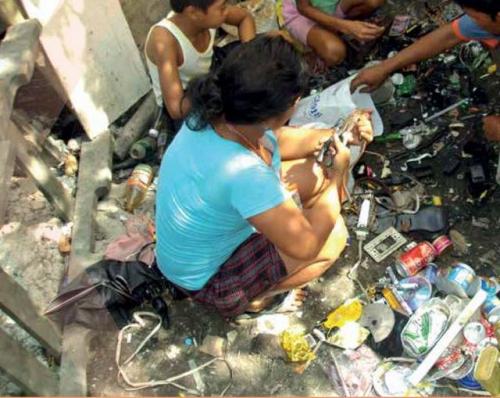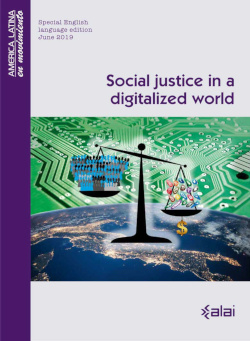Humanizing the digital justice debate
- Opinión

| Article published in ALAI’s magazine No. 542: Social justice in a digitalized world 24/06/2019 |
Gender relations are the warp and weft of society, and they are profoundly so, because human reproduction is implicated fundamentally in those relationships. We don’t reproduce ourselves as human beings, as a human society, except in and through gender relations, (though one could get into a much larger argument about how and why and whether we will ever get to where we’re producing test-tube babies and whatever…) We are not yet there at this point, except in limited ways.
So I think it is important for us to recognize that for now, and for the foreseeable future, that means that, if we believe that there can be no considerations of justice without thinking about humans beings and human relationships, then gender is in it from the outset. Because we cannot think about how, as human beings, we live, interact, survive and reproduce ourselves, except in and through gender relations.
Part of our problem, of course, is that, at least with capitalism, one of the reasons that gender has always been struggling on the margins is because human reproduction, in which gender relations are key, is on the margins. Capitalist accumulation does not care about what happens with human beings, except in very limited and narrow ways, and because of that ensuring human reproduction is always pushed to the side. It is then dealt with only in limited ways and in the margins, not in the mainstream.
What happens because of that relegation to the margins that is at the heart of the capitalist system, is that when we start thinking about gender, tropes of vulnerability and victimhood surface immediately. Women as victims, women as excluded, women as marginalized. Such tropes have been with us, in the context of thinking about gender, almost from the beginnings of this phase of the feminist revolution and women’s social movements, which date roughly from the 1970’s; and they have been with us throughout. The gut response from feminists is to say no, we’re not victims, we’re agents. But even that is simply a kneejerk response to the trope of victimhood and saying “oh poor women”. And then you have women and children and disabled and indigenous in a trope of victimhood and marginality and oppression that is all connected and flows along one line.
The canary in the mine
In my own work, I have been trying to replace that trope of vulnerability and victimhood. Not to say that there are no victims, of course there are, but everybody is a victim in the system, – except maybe Mark Zuckerberg! – but there are also all kinds of victims and of victimization. It’s not specific to women.
So I have been trying to replace that trope with a different one, which is that of the canary in the mine. What happens to women, precisely because of women’s location in the context of this very fractured relationship between production and reproduction, is often a forewarning of what is going to happen overall. And that’s very important, particularly in this digital justice discussion, because you can already start seeing ways in which that may be the case. The canary dies before the miners do, and the canaries are kept there exactly so that the miners won’t die. When the canary dies, get out of the mine!
So in a sense that trope may be a more interesting way of getting out of the idea of victimhood, to say that women may often be the first to experience the negative impacts of the system. So what does this mean for how we think about gender equality in the context of digital justice?
I am not going to make a big distinction here between the third and fourth industrial revolutions; that is, between the era of the entry of big computerization and what we are experiencing now - the transformation of the digital arena, that is threatening to transform all of society and life. For the purpose of this discussion, I shall slide from one into the other. And part of the reason for that is that one of the earliest things that happened with the third revolution of computerization was the financialization of the economy, which predated whatever it is that we are seeing right now. And that critically shapes the larger agenda, within which we are now talking about relations, justice, and how to move forward towards gender equality.
Gender inequality: the digital connections
How do I see the connections between unequal gender power relations on which many from within feminist and women’s movements have been working, and digital justice? I will give just some flashes.
The first is macroeconomics. Finance, trade and tax justice are all critically affected at this point by what has happened between the third and the fourth industrial revolutions. The domination of the real economy of goods and services production, distribution and consumption by the financialized globalization of today with its booms, bubbles and busts, has been made possible by the third and fourth industrial revolutions. The drive to open the world economy to free flows of finance means that national policy space has shrunk dramatically, in both high- and low-income countries. National economic policies are forced to serve the gods of the financial markets, leaving little or no room for policies and financing that support human subsistence and reproduction including the ‘care work’ that women do, provide social protection to all, ensure jobs and decent work, assure decent levels of education and standards of health, or protect the environment and the planet. Women are among the first (the canaries) and most affected by the heartless macroeconomics of today, as has been extensively researched and documented.
The second is livelihoods, where gender relations play a critical role, because of the issue of reproduction. When push comes to shove, the responsibility for undertaking the daily (and often unpaid) work of caring for people and ensuring their survival lands at the doors of women. Women have to feed and take care of families, children, old people, the sick and infirm, and their survival, not just biologically, but on a day-to-day basis. And that immediately gets us into areas like agriculture, fisheries, and food production where the digital is transforming methods of production and consumption, generating inequality and concentration on a global scale. The case of deep-sea mining, for instance, and the so-called ‘blue economy’, which DAWN has been researching in the Pacific, provides a direct and powerful example[1]. A very large proportion of deep-sea mining is for the minerals that go into electronics. And so there is a very direct digital connection there. At the same time, the ‘blue economy’ is being pushed by powerful corporate interests as being sustainable, even as seabed mining threatens to reproduce all the destruction of traditional fisheries that predatory trawling has done.
The third, of course, is labor, and while we keep talking and are very concerned – as we should be – about what happens in factories, there is the question of informal work and also that of unpaid work. Unpaid work, the bulk of which women are responsible for, that’s where you get all human reproduction and it’s also one of the reasons why women are overwhelmingly in informal and poorly paid work. When macroeconomic policies driven by financialization based on digital technologies, shrinks the public resources for social protection, and care work, the hidden tax on women, through unpaid work, starts becoming a killer. It is what makes it difficult and often impossible for women to be in formal labor markets or to demand higher pay and better working conditions.
Finally, the fourth is all of the sectors to do with human development, such as education and health. In these sectors, digitalization is making major inroads, with some positive and many negative impacts. The digital invasion of primary education may make possible some quality improvements in schooling. It also opens the possibility of de-skilling teaching, and replacing higher skilled schoolteachers, often women, by lower-skilled, worse paid part-timers.
I believe that, in our discussions about digital justice, the issue of how we humanize this discussion is central. It is critical that we don’t get swept away on a sea of robots, blinking lights and shining objects. From that point of view, considering what gender means in the context of digital justice has to be part of a critical discourse and a progressive agenda from the very beginning.
Gita Sen is a founder member and currently General Co-coordinator of DAWN (Development Alternatives with Women for a New Era), a feminist network based in the global South. http://www.dawnnet.org.
This is the edited transcript of a talk given at the Workshop Equity and Social Justice in a Digital World (Bangkok, March 2019).
Del mismo autor
- Humanizing the digital justice debate 24/07/2019
- Humanizar el debate sobre la justicia digital 24/07/2019
- Los desafíos de la globalización 28/10/1998
Clasificado en
Clasificado en:
Mujeres
- Paola Ricaurte 10/03/2022
- Giorgio Trucchi 03/03/2022
- Diana Carolina Alfonso, Mónica Miranda 22/02/2022
- Miguel Pinto Parabá 26/01/2022
- Jo-Marie Burt, Paulo Estrada 12/01/2022
Internet ciudadana
- Nick Bernards 31/03/2022
- Paola Ricaurte 10/03/2022
- Burcu Kilic 03/03/2022
- Shreeja Sen 25/02/2022
- Internet Ciudadana 16/02/2022

